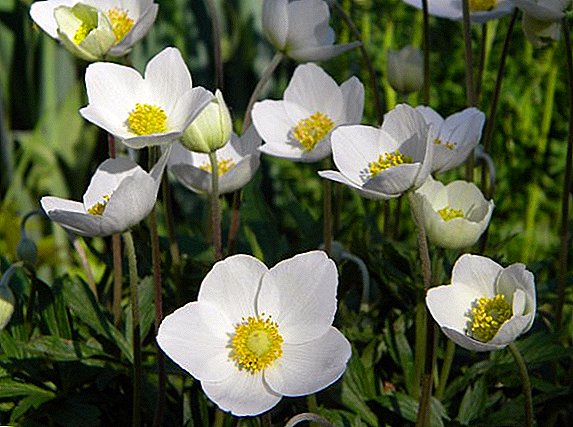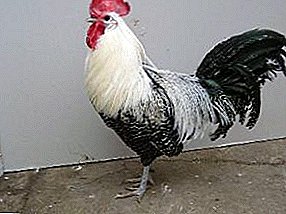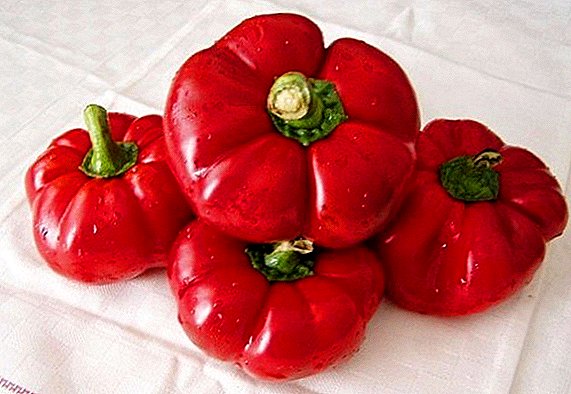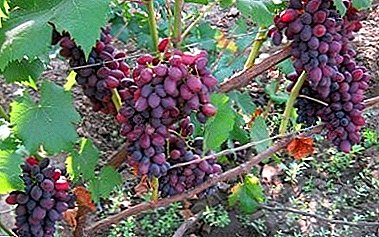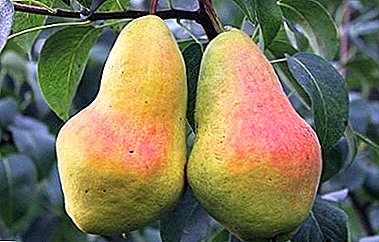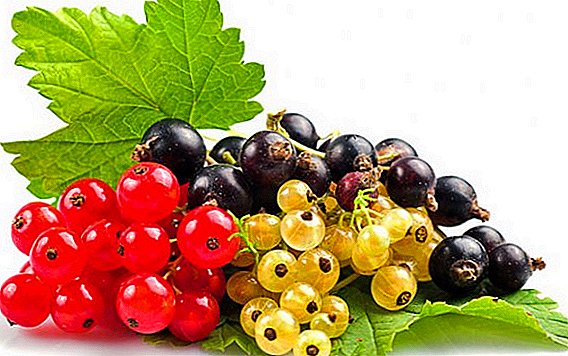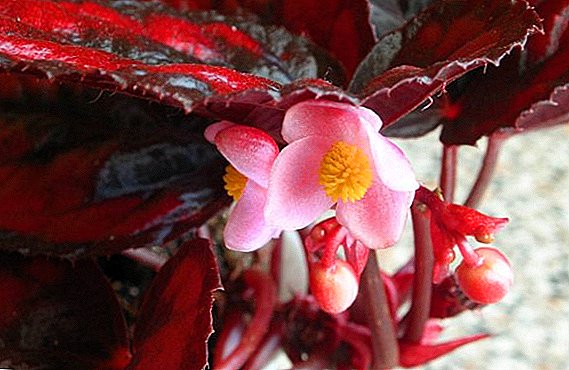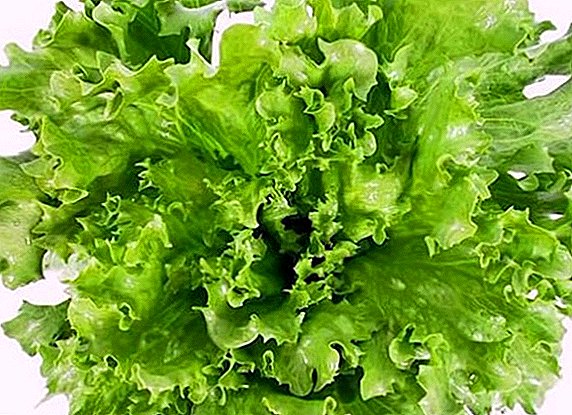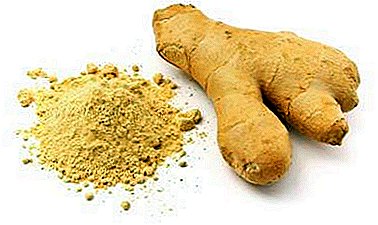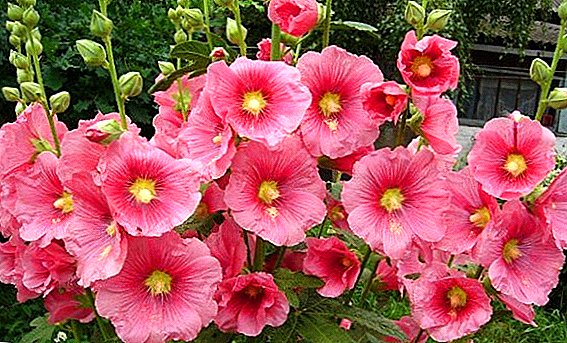 Mallow (stock-rose, mallow) - a plant known to humanity for more than three thousand years.
Mallow (stock-rose, mallow) - a plant known to humanity for more than three thousand years.
Often this ornamental plant is undeservedly forgotten, but it has something to surprise today.
Its main advantage is simplicity and endurance.
For a minimum of effort and attention from your side, the flower will repay you with the richness of shades, the beauty of the inflorescences, delicious honey, healing infusions.
Did you know? Mallow were grown in ancient Egypt, China, India, Ancient Greece and Rome. Mallow can be seen in ancient frescoes, paintings by medieval artists, in folk embroidery.
Varieties of culture
The genus Malvé is represented by 25 species of plants. The most famous and ancient are the Mallow Pink and Lesnaya Mallow (it was they that served as the basis for the breeding of many hybrid varieties).  Mallow and their relatives (hibiscus, alteika, laureate, chinabella, etc.) represent the Malvine family.
Mallow and their relatives (hibiscus, alteika, laureate, chinabella, etc.) represent the Malvine family.
Plant height varies from 0.8 to 2.5 m. Flowers (double, semi-double and simple) in diameter have a size of from 5 to 15 cm (depending on the type and variety).
The color palette of the inflorescences is wide: burgundy, red, purple, pink, white, purple, black, yellow (besides, the mallow is a cross-pollinated plant, and the nearby plants actively exchange colors, creating unique shades).
Did you know? Malva loves the hot sun and dry summer, easily tolerates temperatures above + 45 ° C (mallow roots can extract water from a depth of more than three meters).
Mallow are perennial, biennial and annual. Malva one-year in fact is also a two-year.
In the first year of development, the mallows form a rosette of leaves; in the second year, the stems with inflorescences are thrown out (from 150 to 200 flowers). Begin to bloom in June, bloom in October.
Left after the flowers are boxes of seeds ("balls"). You can collect seeds after yellowing of the boxes.
Did you know? Malva Lesnaya - the only flower of mallow loves shade and blooms only with pink flowers.
Thanks to the selection work, the mallow has taken a worthy place in the design of the garden, many hybrid varieties have appeared - of different heights, different degrees of terry and different colors:
- Queen purple - height 75 cm (as a result of the crossing of the mallow rose and pale althea);

- Chater's Double Pink - height 2 m (double flowers of all possible coloration);

- Nigra - simple flower of violet-black color.

When and where to plant on the plot
When deciding when to sow mallow in open ground, you need to remember that the plant will only bloom next year.
It is possible to make the mallow blossom this year, by planting seedlings in advance (January-March), and after transplanting them into the garden.
Site selection
When choosing a site for planting mallow you need to consider:
- Mallow feels great in the hot sunlight (in the shade the mallow flowers grow dim). The place should be well lit by the bright sun;
- Mallow like light soil (loam) with a high nitrogen content, good aeration. Excess moisture will cause the roots to rot (the lower the groundwater, the better). Sometimes it is advisable to fill an artificial hill on which you can land a mallow;
- long stalks of mallow may suffer from gusting winds. It is recommended to plant mallows in places protected from the wind, or next to a wall, hedge, fence and other support.
- The transfer of mallow (especially an adult plant) is undesirable - a long taproot will be damaged. For perennial plants need a permanent place.
Landing dates
Seeding seeds in open ground is best done from May 25 to June 25.
 The question of how to sow Mallow, will not cause difficulties even for a novice gardener. Mallow seeds are large, 2-3 holes can be placed in one hole (depth 2 - 3 cm) (germination can be low).
The question of how to sow Mallow, will not cause difficulties even for a novice gardener. Mallow seeds are large, 2-3 holes can be placed in one hole (depth 2 - 3 cm) (germination can be low).
You can add a little peat. The distance between the holes is at least 60 cm. After the shoots are thrown out by 3 leaves, the strongest sprout should be left in the hole. With this seeding, the young plant will get strong enough and will be able to withstand the autumn cold.
When planting seedlings planting time other:
- when sowing seedlings in January-February - planting sprouts in May;
- when sowing seedlings in May - planting sprouts in August.
- prepare a nutrient substrate (light mixtures for vegetable seedlings, peat tablets) and peat pots;
- select mallow seeds (the most productive seeds are 1.5-2 years of storage) and soak them before sowing in warm water (+ 47 ° C);
- sow seeds;
- after the seedlings have thrown three leaves, you can dive mallow. After the picking, we grow the sprouts in peat pots (the root can be treated with potassium permanganate);
- maintain the mode from +18,5 to 22 ° С;
- two weeks before the intended disembarkation - temper (bring to a balcony or courtyard, increasing the length of stay);
- plant seedlings on the plot (the distance between them is at least 60 cm).

Important! Growing seedlings, it is best to use separate peat cups - with further transplantation the danger of damaging the roots of mallow is reduced several times.
Main principles for the care of mallow
Mallow is not a capricious plant and does not require complex care. As a rule, it comes down to watering, feeding, pruning, tying, preparing for winter.
Watering and fertilizing the soil
Mallow do not require frequent and abundant watering. In hot weather and occasional rains, mallow should be watered once a week. In dry weather, it is best to provide mallow with regular watering with a small amount of water.
In wet and cool weather, you can do without watering (so as not to provoke fungi). After watering it is desirable to loosen the soil. Weed prevention is usually done once every two weeks.
The fertile soil does not need top dressing. If the soil is poor, then a week before flowering it can be fed with low concentration of phosphate-potassium fertilizer. You can periodically mulch the earth with compost.
Trimming and Garter
 Mallow stalks, 2-2.5 m high (although they have great strength) can bloom during flowering with strong gusts of wind. To prevent this, it is advisable to tie them to the support.
Mallow stalks, 2-2.5 m high (although they have great strength) can bloom during flowering with strong gusts of wind. To prevent this, it is advisable to tie them to the support.
Usually tied to a fence, fence. In their absence, pegs are driven into the ground (at least 1.5 m high) and they tie a mallow to them.
Mallow pruning is practiced to remove wilted buds. Cutting off the dead flowers with sharp scissors we ensure the appearance of new inflorescences.
When breeding hybrid varieties of mallow, cuttings are cut: near the root - for spring planting, the tip of the stem - for summer planting.
Important! The breeding of hybrid mallows usually occurs through green cuttings or division (hybrid characteristics through seeds are not inherited, and many varieties do not produce seeds at all).
Shelter for the winter
 Preparing for wintering is simple. If there are no severe frosts, then the perennial mallow will easily survive the winter.
Preparing for wintering is simple. If there are no severe frosts, then the perennial mallow will easily survive the winter.
However, severe frosts can harm (especially young plants or some particularly sensitive varieties).
In this case, you will need to cover the mallow with dry leaves, spruce branches, fiberglass, cellophane, etc.
Possible pests and diseases, combating them
Mallows are most often affected by a particular disease - rust mallow. The cause of the disease is excess moisture. Leaves really like rusting stains. Such leaves must be cut and burned.
The affected mallow must be treated with a solution of colloidal sulfur or a special preparation (Amistar 250 SC, Nimrod 250 EC, Topsin M 500 SC, Dithane Neotec 75 WG, Score 250 EC, Discus 500 WG).
Important! If the flower is strongly affected, it is better to get rid of it, so as not to infect the rest. Gardeners recommend not to plant mallow in the affected area for two years.
Other diseases include stem cancer, powdery mildew, mosaic virus. Sick leaves should also be destroyed. Antifungal drugs should be used ("Phyto-Doctor", "Mikosan-B", "Trichodermin", etc.).
Of the pests - sometimes garden slugs attack the mallow. You can fight with them chemicals, but it is better to collect in traps (wide and shallow trays with beer), which can be placed around the mallow.
The use of mallow in different areas
Malva is famous not only for its beauty, but also for its useful properties:
- healing. All parts of the plant have medicinal properties (but especially the roots). Decoctions are used as expectorant, anti-inflammatory, enveloping agents;
- technical. Mallow with dark red flowers are used for coloring wine and wool. Mallow Melyuka is used in the manufacture of ropes and hemp;
- food. Many mallow varieties are edible (you can cook, simmer, eat raw). Mallow contains an increased amount of protein and is used as feed in animal husbandry. Mallow is a wonderful honey plant (all other flowers are already fading).

Did you know? Ancient Egyptians used mallow seeds as a means of cleansing the airways of various microbes. The Arabs added kalachik in coffee. In China and Tibet, mallow seeds served as a seasoning for various dishes.


